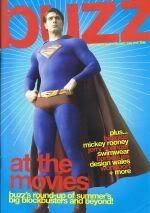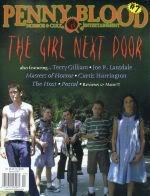Loft (2005)
You can almost see the director working his way down a checklist of Asian horror clichés. Mildly hysterical woman living alone? Check. Water-logged straggly-haired vengeful dead girl? Check. Spooky ooky incomprehensible and thus utterly nonsensical plot? Check.
It’s hard to know exactly what’s going on in Loft. A young writer moves into a house in the middle of nowhere to, theoretically, work on her novel without distractions or excuses. Her creepy editor found the house for her, which wasn’t far out of his way since he’d already rented it out once to another young writer. She just didn’t cut it, though, and the stresses of writing lead to her mysterious disappearance. (Except, actually, she didn’t entirely disappear; instead, she spends her time peering out menacingly from halfway behind any available corner.)
The house isn’t quite as secluded as it seemed, either; the abandoned looking building out back, purportedly an old university building, is actually occupied by a scientist who may be on the verge of becoming famous thanks to his discovery of a mummy in the swamp down the road. Which does, at least, partially explain why property values are so low around there. Weirdly, though, it transpires that another identical mummy was discovered in the same place some years ago. Something strange is going on – something that only gets stranger as the young writer starts vomiting up suspiciously swamp mud-like substances, agrees to babysit the mummy, and embarks on an ill-advised romance with the guy next door, who may or may not have murdered her predecessor. Who may or may not have been possessed by the spirit of the vengeful mummy, before becoming a hollow-eyed lank-haired ghostie herself.
The story’s about as clear as mud, in other words. There are far too many things going on, resulting in none of them being anywhere near properly developed. As a result, anything that tries to be at all spooky, even with all the badly-edited atmospheric music the filmmakers could get their hands on, just ends up being sort of comical.
If you’ve seen the recent anti-piracy adverts that’re showing before movies lately (“The cinema won’t be the only place to watch [insert name of new movie here] when it’s released. You could choose to watch a dodgy version in the quiet hell of your miserably pokey little house.”) you’ll know that, apparently, cinema audiences cuddle up to one another when they’re scared, exchange knowing smiles at the appropriate moments, and practically high-five one another in a huge smug orgy of legitimate movie-watching bliss. After watching Loft in a lovely two-storey Art Deco cinema at a film festival, it’s become a lot easier to buy into those adverts. What began as small, suppressed chuckles and snorts of derision quickly became all-out belly laughs as the film progressed into utter ludicrousness. Every time the ghost woman appeared in a new and bizarre location, the entire cinema dissolved into giggles. Production values must’ve been low; there’s a scene where the ghost is stalking the young writer, and, predictably, hiding around a corner. She glowers, tilting her head to make sure her evil hair is shown to its full extent, then the camera pans across to hide her before panning back to show that, shock! She’s not there anymore.
Given the utter failure of the movie overall to induce anything resembling fear, it genuinely seems more likely that she’s just nipped off for a cup of tea than that she’s mysteriously and supernaturally vaporised. It’s clearly meant to be scary, but just comes off as cheap. Spending more than half the movie establishing that the mummy isn’t moving, or in fact doing anything more threatening than petulantly chucking her blanket on the floor every now and then, could have been effective build-up to a real scare, if it weren’t for the fact that the pay off doesn’t. It’s so half-hearted, and the mummy so slow and ineffectual, that it’s really just not worth it.
Ambiguity is a valuable tool in the right hands, but in the wrong ones, confusion reigns. After a couple of false resolutions, the actual, astonishingly abrupt ending is badly fumbled, provoking only a sort of stunned laughter. The film’s defining moment is possibly during a conversation between the writer and the scientist: they’re sitting in the car, in the middle of the night, discussing whether or not the previous occupant of the house was murdered, and what they should do about it. Their options are: 1. call the police; 2. head out into the woods in the middle of the night and dig for her corpse to prove she’s really dead after all. They choose the latter. (There’s some stellar corpse-burying work here, too; the girl’s head is actually sticking out of the mud.) It’s as though the film is verging on postmodernity, almost wants to give its audience a knowing nod, “yes, we know we’re in a horror movie and so we’re going to act like it”, except instead, it’s just flat-out stupid.
Never mind all that, though; I hear it’s going to get a Hollywood remake.
IMDB link










No comments:
Post a Comment